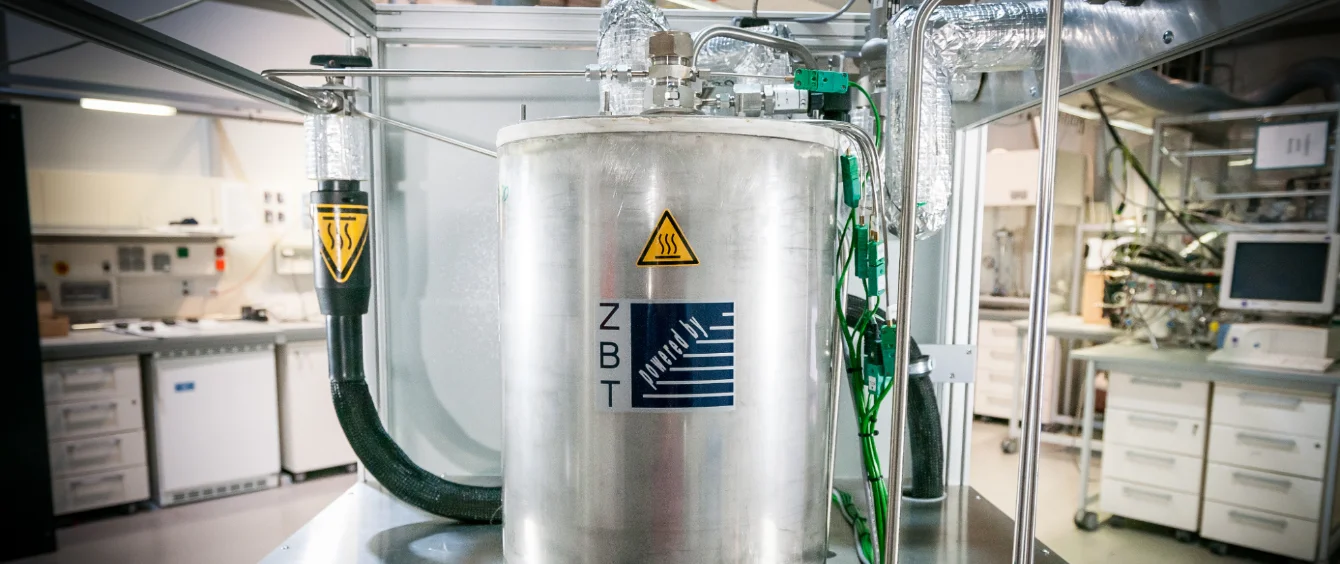Ammonia is one of the beacons of hope of the energy transition. The German government recently announced a nine billion euro investment as part of a revamped national hydrogen strategy. The objective is to expand infrastructure for hydrogen produced from renewable energy. Meanwhile, researchers at The University of Duisburg-Essen (UDE) and the Fuel Cell Technology Centre (ZBT) are placing their bets on a different source of energy in their Power to X concept: the colourless gas ammonia.
Ammonia is one of the most common base materials in the chemical industry. Annual production exceeds 125 million metric tons, with the lion’s share being processed into fertiliser. Producing ammonia requires huge amounts of fossil fuel, releasing several million metric tons of carbon dioxide into the atmosphere.
Florian Nigbur, energy engineering expert at UDE, and Michael Steffen, Head of the Department of Energy Sources and Processes at ZBT in Duisburg, intend to demonstrate that there is another way. The scientists are developing a carbon-neutral technique for powering cell towers using ammonia.
Millions of metric tons of carbon dioxide are blown into the atmosphere the world over when producing ammonia. How can this very substance spur the energy transition?
Ammonia production is indeed almost solely based on fossil fuel – mostly natural gas. Further energy sources used are coal and oil. But ammonia can also be obtained in a sustainable manner. This is when we talk about producing ‘green’ ammonia.
How does that work?
It’s like producing hydrogen. It requires electrolysis for which we use electricity generated from renewables. In addition, you need an air separator to capture nitrogen from the air. Then we apply pressure to obtain hydrogen from electrolysis and make it bond with the nitrogen from the air to form ammonia in a reactor.
Hydrogen is all the rave, drawing millions in research funds. Why are you exploring ammonia instead of hydrogen?
Hydrogen is a key element of the energy transition, but doesn’t stand a chance to prevail across all areas. It comes up against its limits especially in applications requiring high energy density to store large quantities.
I think it’s helpful to use numbers to illustrate what we’re driving at: One can store about 1.7 kWh per litre of hydrogen compressed at a pressure of 1,000 bar. In liquid state, this storage capacity rises to 2.4 kWh, but liquefaction requires an enormous amount of energy. By contrast, ammonia turns liquid under very low pressure, starting at roughly 8 bar, and at 3.3 kWh has a higher energy density than hydrogen. In simple terms, it can store much more energy.
On top of that, the technique is known the world over and is not very complex. Whereas hydrogen must be transported and stored in small pressurized gas tanks, tens of thousands of metric tons of ammonia can be transported in large tanks used for liquefied natural gas (LNG). This brings advantages in logistics, storage and, in the final analysis, of course costs as well.
These are the advantages you intend to seize in order to power cell towers. How did you come up with this idea?
The idea was born in an EU project. The objective was to figure out how to power cell towers in remote areas lacking sufficient power grid coverage. The most common solution has been to use diesel-powered generators, which are not very good to the environment. Ammonia could enable easy storage, transport and use of electricity from renewables to produce power wherever needed, without emitting carbon dioxide. What’s more, the technology can be managed easily.
How exactly does this work – I mean, how do the cell towers receive power?
Each cell tower has one of our modules sited beside it. These modules mainly consist of an ammonia tank, what is known as a ‘cracker,’ and a fuel cell. In the cracker, the ammonia is broken down into a mixture of gas made up of 75 percent hydrogen and 25 percent nitrogen. This powers the fuel cell, which converts the hydrogen to water using atmospheric oxygen. This generates electricity which we can use to power the cell tower.
The lynchpin of your research is the ammonia cracker. What exactly does it do?
In our cracker, which is run at a temperature of 700 to 800 degrees, we use a catalyst to break down ammonia into a gas mixture with a high share of hydrogen. This process requires heat. The ammonia cracker contains a burner that provides the necessary heat. The fuel cell’s exhaust gas is used as fuel for this process. It consists of hydrogen, nitrogen and some water and is still highly flammable. This setup, combined with sophisticated heat management, makes for a highly efficient system. The ammonia cracker already has an efficiency of more than 90 percent.
Instead of storing energy as hydrogen directly, you take a detour via ammonia. Are the benefits so great as to warrant taking this additional step?
The cracker may be an additional component, but we believe that ammonia will be the more affordable alternative in some applications, thanks to its high energy density and simpler storage technology. The advantage is that this reduces transport routes. Especially when travelling over long distances, it makes a difference whether a ship or a lorry with ammonia tanks is sent on its way or two ships or lorries embark on their journey with hydrogen tanks. One has to look at the entire energy chain in order to make a precise statement. Long transport routes and storage periods as well as the need for high energy density tend to favour the benefits imparted by ammonia. We aren’t intent on replacing hydrogen completely, but consider ammonia to be a hydrogen carrier that can complement the hydrogen business well in certain areas.
What about conversion losses?
We currently estimate the losses incurred when generating electricity from ammonia to amount to 50 percent, depending on the fuel cell. Losses are slightly smaller when using pure hydrogen since this reaches a higher efficiency of about 55 percent. So, as you can see, the difference between ammonia and hydrogen is not significant and is merely one of several criteria. One must always bear in mind the required techniques, raw materials and costs as well.
Can this technology be used in other areas?
We have developed and tested the first prototype ammonia cracker. Now we’re working on the details. At the end of the project, we want to present the world with an optimised cracker system in which all components are matched to each other perfectly.
This would give us a zero-emissions energy source and a technology which could be used to power stationary facilities at virtually any location.
If you think this through, it’s obvious that there are further potential fields of application. Importing sustainable electricity from Africa is an option that has already been considered in the EU. However, until now, such concepts have lacked the right storage medium. Ammonia could enable vast amounts of energy to be transported. Propulsion is another conceivable application. We’re preparing several projects seeking to fuel ships with ammonia. Aviation is another sector that must be decarbonised, for which the first ammonia-based approaches are already in play.
Photo credit: ZBT


